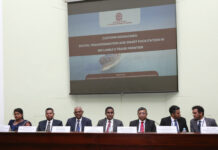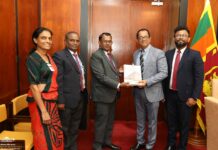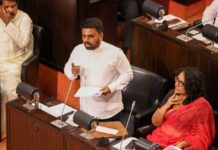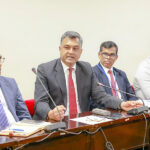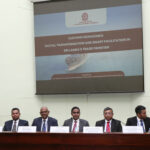Downriver of Bowatenna along this river is the spanking new Moragahakanda reservoir, the latest and last of the ambitious Mahaweli Development Program projects. Completed as recently as 2018, Moragahakanda also comprises of the Kalu Ganga reservoir scheme. The latter, completed at the same time and originating deep in the recesses of the Knuckles range, is itself a tributary of the Amban. The waters of this reservoir are nevertheless diverted via a 12km long tunnel to Moragahakanda as the confluence is downriver of the dam.
The Kalu Ganga reservoir harbors a little known yet now defunct and inundated secret of the Hattota Anicut. This is a 30km diversion built by Agghabodhi in the seventh century to divert waters to the famous Elehara canal down river of the Moragahakanda Dam. Having harnessed these waters from the Kalu Ganga, as well as from the Thelgamu Oya, the Moragahakanda reservoir is being earmarked for a further ambitious effort via the Upper Elehara Canal Project (UECP) currently under construction, to transfer waters via South Asia’s longest irrigation tunnel at 28km and a further 65 km of canals to the Mahakandarawa, Manankattiya tanks and again to the Hurulu Wewa.
In parallel is the construction of the North Western Province Canal Project (NWCP), which will tap into an outlet from Lenodara and carry Mahaweli waters via a series of tanks and 78km of canals into the Mi Oya and Deduru Oya basins. These two river basins are both replete with ancient irrigation networks of their own, spanning from pre-Vijayan times to Parakramabahu in the late 10th Century. Like a giant octopus whose tentacles are gradually encasing the island, these two canal projects will thus complete the Mahaweli’s western most encroachment.
Literally yards below the Moragahakanda dam along the Amban lies the iconic Elehara anicut and Yoda Ela canal. Remnants of the original stone dam built by Vasaba in the first century, increased in height by Mahasen in the third, likely restored by Parakramabahu in the 10th are still visible today. The diversion was slightly relocated as the canal was restored by the British during the early part of the 20th century.
The waters thus diverted travel along the picturesque Yoda Ela, originally also built by Vasaba, over 30km to the Minnneriya (Mahasen third century) and Giritale (Agbo seventh century) tank complexes. Water is further transferred from Minneriya to the larger Kaudulla tank, also attributed to Mahasen, but steeped in legend as actually a construct of his estranged sister. Princess Bisobandara, banished from the palace for her love of a commoner.
Waters from Kaudulla then find their way to the Kantale (Gantala) tank, built by Agghabodi in the seventh century, and the spent waters of this system finally find their way into the Tampalakamam bay in Trincomalee, a little north of the Mahaweli’s natural estuary in Koddiyar, and 95km as the crow flies from the commencing diversion at Elehara.
As the Amban, after its confluence with the Kalu, continues as the western and northern boundary of the Wasgamuwa National park, it makes its final bequeathment to this island’s ancient and modern civilization at Angamadilla. Originally built by Upatissa around the fourth century, along with the Akasa Ganga canal to divert waters to the Thopawewa, the prolific Parakramabahu enhanced both dam and canal to amalgamate five existing tanks and create and feed the great ‘Sea of Parakrama’ or Parakramasamudraya, considered the largest of the ancient world’s reservoirs.
Having thus exhausted itself, the Amban continues further east to eventually coalesce with its great benefactor the Mahaweli at the southern border of the now aptly named Flood Plains National Park.
But our story must now double back to where we stepped off the great river at the Polgolla barrage. After this remarkably significant diversion, the Mahaweli meanders its way through the salubrious suburbs of the historic city of Kandy, into the now inundated Teldeniya valley. And here it emerges at what is probably the jewel in the crown of the modern Mahaweli Development Scheme: Victoria.
A gigantic double curvature dam standing 122m tall and with a crest length of over half a kilometer, it was mostly funded by a grant by her Majesty’s government in 1978. Coincidentally and perhaps suitably named in recognition of both the Royal bequeathment and the submerged Victoria falls, the dam’s primary function, with 722m cubic meters of storage, is delivering an installed capacity of 210MW of hydro power, the highest of all along the Mahaweli system, and capturing and regulating waterflow for the myriad of irrigation schemes further downriver.
Twenty km downriver from Victoria is the equally impressive Randenigala Dam. Completed a few years after the former with German engineering, Randenigala, though a rock filled dam of only 90m height and a crest of 300m, nevertheless creates the largest reservoir in the Mahaweli scheme at over 860m cubic meters of storage capacity and has an installed hydroelectricity capacity of 120MW.
Under 3km downriver from Randenigala, straddling the famous Rantambe gorge, is the small Rantambe dam creating a reservoir of 21m cubic meters and an installed capacity of 52MW. Just below this dam the Mahaweli once again embarks on a generous dispersion of its wealth, instigated by both ancient and modern man.
On the left bank lies the ancient Minipe anicut. Originally built by Dhatusena in the fifth century, extended by Agghabodhi in the sixth to around 22km, and thought to have been further extended a staggering 78km by Sena II in the ninth century all the way up to Angamedilla, the weir of the modern Minipe is currently being further raised to divert even greater volumes of Mahaweli waters into what is known as the Mahaweli E system, one of the many agricultural zones labeled with alphabetical nomenclature along the modern Mahaweli scheme.
On the right bank, directly opposite the ancient Minipe anicut lies the ‘new’ Minipe anicut and the modern Loggal Oya canal. Running 30km up to the Ulhitiya and then Ratkinda reservoirs, these are feeder tanks that eventually carry Mahaweli waters through a five km long tunnel to the legendary Maduru Oya reservoir, to feed the largest resettlement systems of B & C of the Mahaweli scheme.
Still shrouded in debate and mystery as to its origins, the Maduru Oya dam is famous for the revealing of its ancient sluice upon modern man’s survey and excavation for the optimal site for a new reservoir. Dated to the first century BC, and thought to have been constructed by Katukanna Tissa, further excavation and analysis of earthen works speculates that the original dam may have pre-dated Vijayan times. The modern Maduru Oya reservoir, sporting a surface area of 6,400 acres, is only second to the giant Senanayake Samudra in Gal Oya, and harbors an inland fishing industry replete with idyllic fleets of colorful sailing outriggers.
Having dispersed a considerable share of its wealth, and finally stepping off the central highlands, the Mahaweli now continues its journey from Rantambe north along the great flat lands of the north east. Past the sacred city of Mahiyangana, its literal translation meaning ‘flat land’ in ancient Pali, the Mahaweli now enters the natural wonders of National Parks and Wildlife Reserves. All legally constituted as part of the accelerate Mahaweli Development Program starting in the early 1980s, these parks, though now the purview of its denizens of herds of wild elephant, mugger crocodiles and white bellied sea eagles, still harbor the secret relics of an ancient relationship between the river and its people.
Approximately 55km north of Mahiyangana along the Mahaweli lie the Dastota Rapids and Kalinga Island. Now part of the Wasgomuwa National Park, and the first of a series of large islands along the Mahaweli, legend has it that Kalinga, with its gigantic hardwood trees, was the repository of a great ship building industry from which ships were launched and navigated to sea.
While the island is littered with little explained monolithic ruins, ancient narratives and topographical evidence also speak of two spectacular canals, one on each bank just above the rapids that nourished fields and habitats far beyond. On the left bank are the remnants of the Kalinga Yoda Ela. Allegedly built by Dhatusena, it merged with, and with some spectacular engineering ingenuity, crossed the Amban at a weir downriver of Angamedilla and carried water over 50km north to nourish the fields as far as Kaudulla.
On the right bank are the remains of the Gomathi Ela, built by Mahasen; it carried waters over 40km to the Maduru Oya basin. Thus, Mahaweli waters had long been utilized for the nourishment of a civilization that the modern system has only begun to replicate in the late 20th century.
Further down river, about half-way through the Flood Plains National Park, the Mahaweli enters a controversial zone of its geological history. Aerial photographs, and now with the benefit of online satellite imagery, show the faint trace of a dry riverbed to the west of the current trajectory. This trace runs approximately 25km before re-joining the current path of the river.
The famed Somawathiya Chaitya lies adjacent to this dry river, on its eastern bank, but now well toward the west of the current river. Chronicled to have been built by Kavan Tissa circa second century BC of the Ruhunu Kingdom in recognition of his sister Princess Soma, and whose kingdom bordered the Mahaweli, it gives further credence to the fact that the river has likely changed course over 2,000 years ago.
But the historical civilizational consequences of this are profound and speculatively mysterious. Closer scrutiny at the possible trajectories of the river show that the original course would have crossed what is the current trajectory at almost right angles, both just a little north of the Somawathiya temple, as well as closer to the sacred site.
Given the hydrological power of the flow, this author will postulate that the ancient Mahaweli, prior to its change of course, would have contributed a greater volume of perennial water to both the Verugal Ara as well as the Kandakadu Ara, two branches of the Mahaweli that veer off to the east at the exact site of these crossings.
These two waterways, while today barren and dry during most of the year, save for a seasonal man-made sand bagged barrage at Kandakadu, would have, over 2,000 years ago, carried a far greater volume of water into what is Gangapahalawela, Angodavillu, Mavil Aru and the Allai tank in Seruwawila.
These names and the areas they refer to evoke legends, folklore, and cryptic references in chronicles of ancient irrigation networks and an ancient thriving kingdom in and around today’s Serunuwara and Somapura. The jungles of Somawathiya Sanctuary today are replete with scattered ancient ruins, mostly undocumented, un-referenced and likely yet undiscovered giving further evidence to the existence of a kingdom of this island’s history that is largely unknown, and more importantly for this narrative, the Mahaweli’s likely contribution toward it.
The Mahaweli, along the remainder of its northern journey, meanders through large flood plains, where evidence lies of historical seasonal usage of their alluvial soils, as well as modern efforts of trapping some of these seasonal floods into man-made lakes such as Janaranjana Wewa a little south of Sooriyapura. North of the Allai-Kantalai Road, the Mahaweli starts to break up into mangrove wetlands and numerous deltas prior to breaking free into the ocean at Koddiyar bay.
But the story of man’s dalliance with the Mahaweli has not ended here. The second phase of the North Central Province Canal Project is to carry the Mahaweli’s water all the way up to the Northern Province to Iranamadu, the island’s northern most tank. Perhaps again on the back of ancient tanks and channels built by Mahasen (Kalnadinna), Vasaba (Thannimurippu) and Agghabodhi (Vavunilkulam), the waters of the Mahaweli will reach this ultimate destination.
May be then this island will be finally united. Not just from north to south, but across class and caste, language and philosophy, and political partisanship. Hopefully driven by a newfound sanity among its denizens, yet symbolically attested to by the waters of the Mahaweli.




